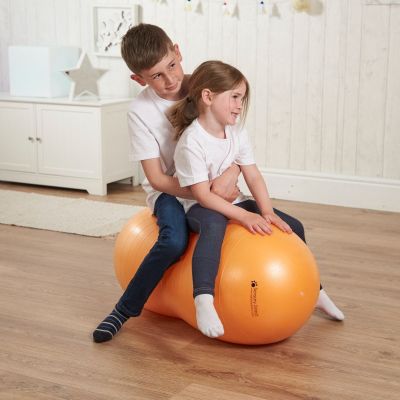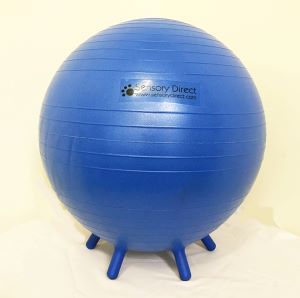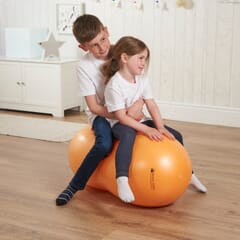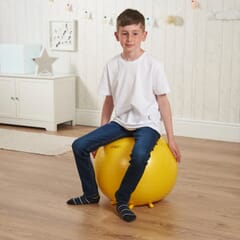Get exclusive deals you won't find anywhere else straight to your inbox.

#AskTheOT - All About Therapy Balls
At Sensory Direct it's our job to help each and every customer get the product that's right for them.
Together with a network of Occupational Therapists and professionals throughout the UK we aim to provide help, support and advice across a range of topics.
Each quarter we will team up with a series of OT's and like-minded professionals to answer a series of questions across a variety of topics.
Why, we hear you say? Well, to put it simply, at Sensory Direct we aim to help people.
By providing professional support alongside our own personal experience and product knowledge, we can give the best support and advice to you.
For this edition of #AsktheOT we were delighted to once again work with Future Steps Occupational Therapists Consultancy.
We put their Occupational Therapists to the test and asked them some of our most frequently asked questions all about Therapy Balls.
What are Therapy Balls and are there different types? 
A therapy ball is a gym ball used in a therapeutic way.
There are different sizes and types such as tactile therapy balls that have spiky surfaces.
There are also different shaped balls such as peanut balls.
What are the benefits of Therapy Balls?
There are many benefits of using therapy balls.
They can help with posture, energy levels, balance, and correcting reactions.
Which type of Therapy Ball should I choose and why?
When choosing a therapy ball it is important to consider the height of the child and the reason and purpose as to why and how you are using the therapy ball.
For example, if you want to develop the tactile system you would need to increase tactile input. This can be done by using a spiky ball.
If you want to develop postural stability, you could use a peanut therapy ball to do walkouts. This is where you kneel behind and walk over the ball with hands on floor.
If you are developing balance or correcting reactions and posture and want to increase energy levels, you could use a smooth, round therapy ball for bouncing.
Is there a minimum age recommendation for using a Therapy Ball?
There isn’t a minimum age recommendation for using a therapy ball. However, it is important to consider the safety and skill level of the individual.
For example, if the child requires adult support such as stabilising their hip to enable them to safely complete an activity.
How do I know what size Therapy Ball to get?
The size of the therapy ball depends on the height of the individual but is also dependent on the type of activity the ball is being used for.
What exercises can I do with a Therapy Ball?
There are numerous types of activities that you are able to do with a therapy ball, such as:
- Bouncing (seated on therapy ball)
- Walkouts (kneeling behind and walking over the ball with hands on floor)
- Squishing inversion (laid over in supine, or prone with head below hip height) for regulation
- Pushing against wall (to get feedback into muscles) for proprioceptive input
- Bouncing the ball, which is good for developing the individuals ability to gauge force
- Bilateral sequencing (using both sides of the body together) ie. balancing
 Who are Therapy Balls suitable for and what conditions might they help with?
Who are Therapy Balls suitable for and what conditions might they help with?
Therapy balls can help a range of individuals from childhood through to adulthood.
Therapeutic use of a therapy ball can positively impact a range of things.
However, this would be dependent on the individual's sensory motor and cognitive skill base.
Where can Therapy Balls be used (indoors / outdoors?) and are there other products you can use them with for additional sensory input?
Therapy balls can be used in many different environments. However, it is important to consider the individuals safety and ensuring the ball will not be damaged.
There are additional products that you could incorporate for additional sensory input such as using different textures to help with tactile difficulties.
Squishing can also be done while the child completes puzzles and games to improve fine motor skills.
Throwing and catching can also be done whilst on the therapy ball.
Is there a weight limit for using a Therapy Ball?
When purchasing a therapy ball it is important to check with the supplier for the ball you purchase as the weight limits will vary depending on type and size.
Is there a suggested time limit for using a Therapy Ball?
The time limit for using a therapy ball will depend on the child, activity, and goal. It would also depend on the individual’s tolerance of movement and the skill level of the individual.
If you have any questions you'd love to feature in another #AsktheOT article, please get in touch at admin@sensorydirect.com.
Please note, this article provides general advice on a given topic(s), which may or may not be suitable for all conditions / circumstances.
For individual advice and support specific to you, we would always recommend seeking guidance from your Occupational Therapist.





